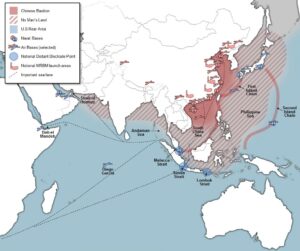The Navy’s standard F-18 Hornet can hit targets roughly 600 miles from the carrier without refueling. Against China, that’s not enough: Chinese anti-ship missiles like the DF-21 and DF-26 have ranges between 2,000 to 2,500 miles. As a result, “the air wing is what drives much of the carrier’s vulnerability,” McGrath said. “If we create… an air wing that buys some of that range back, then the aircraft carrier operates in a less risky profile,” striking from greater and safer distances.
Central to this long-range future air wing is the UCLASS drone, Unmanned Carrier-Launched Airborne Surveillance & Strike. There’s been a fierce debate over whether UCLASS should be optimized for long-duration surveillance patrols, with strike secondary — the Navy’s position — or for deep-penetration strikes, with surveillance secondary — the position of Rep. Forbes and Sen. John McCain. McGrath and his colleagues say that we need both, even if that means buying two kinds of UCLASS aircraft.
Could the Navy's First Carrier-Launched Drone Be an Aerial Tanker?
With the drones-on-a-carrier concept successfully validated, the next step is UCLASS,
or Unmanned Carrier-Launched Airborne Surveillance and Strike. UCLASS
will be a real aircraft, bought in quantity and assigned to carrier air
wings worldwide. Although the aircraft would technically be capable of
doing both reconnaissance or strike, different factions in government
and beyond have proposed that it should be more capable of doing one
better or the other.
That the UCLASS would turn out to be a tanker would be a real surprise. But the new aircraft, Defense News reports, will
be the Carrier-Based Aerial-Refueling System—CBARS for
short—primarily a tanker, with a minor in reconnaissance capability.
CBARS
would leverage an aircraft carrier's existing combat power, extending
the combat range of the Navy's Hornets, Super Hornets, and eventually
F-35 Joint Strike Fighters. Ten strike versions of UCLASS makes ten
strike platforms sure, but ten CBARS drones could permit twice as many
Hornets and F-35s to strike targets farther away.
CNO: Navy Should Quickly Field CBARS To Ease Tanking Burden on Super Hornets - USNI News
Speaking at the American Enterprise Institute, CNO Adm. John Richardson said the newly redesignated Carrier Based Aerial Refueling System – formerly the Unmanned Carrier Launched Airborne Surveillance and Strike (UCLASS) program – will help ease the burden on the F/A-18E/F Super Hornet fleet, which is struggling to get out of a readiness trough, by covering the tanking mission.
“The tanking mission will liberate five or six aircraft, strike fighter aircraft, that are doing tanking missions right now. They’ll be off doing strike fighter kind of missions,” Richardson told reporters during a roundtable after his AEI talk.
“So there’s a real benefit there. It extends the range – it depends on how you employ them, you can just imagine, you don’t have any pilot fatigue in that tanker so there’s all sorts of benefits to doing that.”
Video: Drones Perform Closest-Ever Autonomous Refueling Maneuver | Popular Science
Autonomous aircraft offer plenty of benefits — they can fly long distances at high altitudes, they can take off and land by themselves, etc. — but they're still not self-sufficient, requiring pit stops to refuel. This will change next year, when Northrop Grumman attempts to refuel two Global Hawk drones in flight, allowing for a week-long journey. It's part of a $33 million DARPA program called KQ-X, which seeks to prove autonomous refueling.
CNO: Navy Should Quickly Field CBARS To Ease Tanking Burden on Super Hornets - USNI News
Speaking at the American Enterprise Institute, CNO Adm. John Richardson said the newly redesignated Carrier Based Aerial Refueling System – formerly the Unmanned Carrier Launched Airborne Surveillance and Strike (UCLASS) program – will help ease the burden on the F/A-18E/F Super Hornet fleet, which is struggling to get out of a readiness trough, by covering the tanking mission.
“The tanking mission will liberate five or six aircraft, strike fighter aircraft, that are doing tanking missions right now. They’ll be off doing strike fighter kind of missions,” Richardson told reporters during a roundtable after his AEI talk.
“So there’s a real benefit there. It extends the range – it depends on how you employ them, you can just imagine, you don’t have any pilot fatigue in that tanker so there’s all sorts of benefits to doing that.”
 |
| DARPA
KQ-X (Global Hawk) - Unmanned Aerial Refueling Tanker Demonstrator
Vehicle - History, Specs and Pictures - Military Aircraft |
Autonomous aircraft offer plenty of benefits — they can fly long distances at high altitudes, they can take off and land by themselves, etc. — but they're still not self-sufficient, requiring pit stops to refuel. This will change next year, when Northrop Grumman attempts to refuel two Global Hawk drones in flight, allowing for a week-long journey. It's part of a $33 million DARPA program called KQ-X, which seeks to prove autonomous refueling.
Related/Background
- Good-Bye, UCLASS; Hello, Unmanned Tanker, More F-35Cs In 2017 Budget « Breaking Defense - Defense industry news, analysis and commentary
- Rep. Forbes Decries Cuts To Carrier Wings, Cruisers & UCLASS In Navy 2017 Budget « Breaking Defense - Defense industry news, analysis and commentary
- Navy Challenges Hill on Carriers, UCLASS, & Cruisers In 2017 Budget « Breaking Defense - Defense industry news, analysis and commentary
- Good-Bye, UCLASS; Hello, Unmanned Tanker, More F-35Cs In 2017 Budget « Breaking Defense - Defense industry news, analysis and commentary
- Unmanned CBARS Tanker Air Segment Draft RFP Expected Later This Year - USNI News
- UCLASS reborn as US Navy spy-tanker

No comments:
Post a Comment